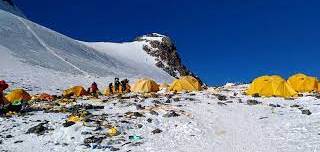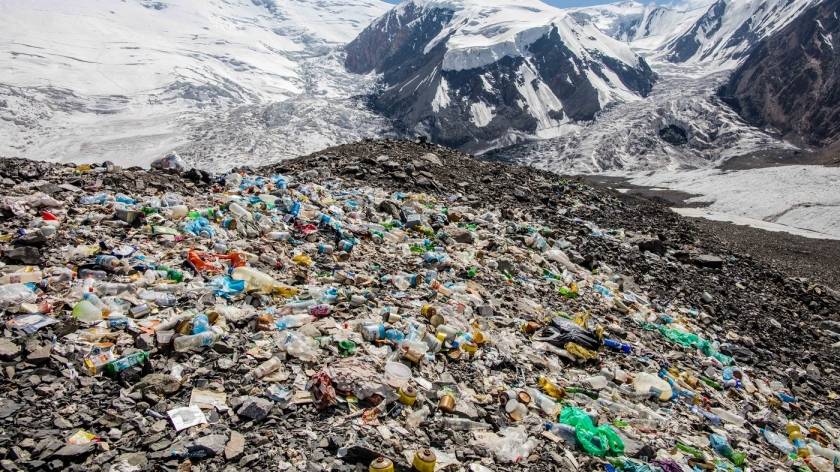
Nepalese mountaineer Nirmal Purja has spent years climbing the world's highest peaks. Over a seven-month period in 2019, he climbed the 14 mountains over 8,000 m. Never before has accomplished such a feat in such a short time.
But on a recent visit to Mount Manaslu in Nepal, the eighth highest mountain in the world, Purja had no ambition to reach the top. He was there to clean up piles of garbage, including ropes and oxygen cans, left behind by other climbers.
Purja, the star of a new documentary Netflix Peaks 14, and his team would collect nearly 500 kg of waste. They are now planning to climb another infamous peak, Mount Everest.
"I have seen first-hand the effect of climate change and waste in the Himalayas," said Purja, who was recently appointed mountain advocate for the United Nations Environment Program (UNEP ). “We want to protect and restore these sacred mountains for all who respect them and for whom these places are their home. "
In recent years, and especially during the COVID-19 pandemic, tourists have flocked to the mountains of the world, leaving behind piles of trash. A recent survey of 1750 people from 74 countries mountain revealed that 99.7% of them have seen the waste and litter on a trip in the mountains. These were mainly plastics, organic waste and paper or cardboard, especially on or near trails, near parking lots or rest areas.
According to the survey, 60% saw an increase in waste in the past five years, while more than 75% spotted COVID-19-related waste, such as masks or bottles of hand sanitizer . The survey was carried out by GRID-Arendal, a non-profit environmental group, UNEP, the Secretariat of the Basel, Rotterdam and Stockholm Pollution Conventions and partners.
"We must all act so that together we make a difference for the good and the protection of these beautiful mountains." Nirmal Purja, mountaineer
Downstream threat
Although they appear imposing, mountain ecosystems are fragile, experts say. The wastes pose a threat to wildlife and pollute the water, exposing communities downstream to major health disks. Most plastic and other waste is moved by wind, melting glaciers and rain, and ends up in rivers and oceans. This is of particular concern as the mountain ranges with their glaciers, snowcaps, lakes and streams act like the world's water towers, providing fresh water to 1.9 billion people.
"The crisis of Covid-19 is an opportunity to rethink mountain tourism and its impacts on natural resources," says Matthias Jurek expert UNEP mountain ecosystems. “ We need to promote more sustainable tourism in mountain regions to prevent, stop and reverse their degradation. If done right, mountain tourism can help mountain communities lead more sustainable lives. "
 Each climber visiting the Sagarmatha National Park in Nepal, home to Mount Everest, generates about 8 kg of waste, most of which are left on the mountain. Photo: GRID-Arendal / Jason Sheldrake
Each climber visiting the Sagarmatha National Park in Nepal, home to Mount Everest, generates about 8 kg of waste, most of which are left on the mountain. Photo: GRID-Arendal / Jason Sheldrake
A joint analysis by UNEP, the Basel, Rotterdam and Stockholm conventions and GRID-Arendal examined visitor activity in mountain areas. He found that tourists generate significant amounts of solid waste and sewage, which can pollute groundwater, streams, lakes and soil. Some types of waste, including pharmaceuticals, batteries and hygiene products, may additionally contain hazardous chemicals, the analysis says. The summary is part of a publication that has been unveiled by the United Nations Food and Agriculture Organization (FAO) and the World Tourism Organization (WTO), entitled Sustainable development mountain tourism.
“Although mountaineering has compelling economic benefits for local communities, the right balance needs to be struck to ensure that the impact of mass mountain tourism is properly managed,” Jurek explains.
Solutions
Experts say raising awareness of the consequences of mountain pollution is crucial to cleaning up the slopes of the world. To this end, the International Olympic Committee, in collaboration with UNEP and mountain sports federations, published 10 Steps to become a hero of the mountain, a practical guide on how mountain visitors can reduce their environmental footprint.
The campaigns carried out by UNEP and related initiatives such as Beat Plastic Pollution , Clean Seas, Adopt a River and Tide Turners Challenge , aimed at reducing plastic waste in the environment and to raise awareness of the threats plastic pollution poses to ecosystems. Globally, there are many such campaigns, as well as laws in a growing number of countries to ban certain single-use plastics, including bags.
While this has met with some success locally, according to UNEP data, plastic pollution is set to double by 2030 , a potentially perilous development for sensitive mountain ecosystems, according to experts.
“The solution is a ban on single-use plastics, reducing the consumption of plastic products, financing and developing innovative alternatives, recycling and, ultimately, a circular economy in which everything is reused or recycled, ” explains Jurek.
We must promote more sustainable tourism in mountain regions in order to prevent, stop and reverse their degradation. Matthias Jurek, UNEP
On the mountains themselves, part of the solution is to help preserve the wilderness by also creating protected areas along the trails as well as cabins and shelters that take into account local practices and culture. .
"Visit the mountainous regions is a great way to live and feel the sense of fear that these large landscapes inspired no doubt," said Carolina Adler, president of the Commission for Protection of the mountains of the UIAA. "As stewards of the mountains, the mountaineering community is of course also supposed to play its part to ensure that we not only leave no trace, but we also set an example and inspire others to protect these environments with us - now and for future generations. "
The first detailed draft of the new global framework for biodiversity beyond 2020 calls for urgent action to reduce pollution to levels that do not harm biodiversity, ecosystem functions and health human. “Pollution, along with climate change and loss of biodiversity, cannot be tackled in isolation,” says Jurek. “We need incentives and innovative and imaginative solutions to better manage mountain waste. "
International Mountain Day , which falls on 11 December, focuses on sustainable mountain tourism this year. Its objective is to raise awareness of the value of mountain ecosystems for humanity and to stimulate action and awareness to protect them from pollution.
This is something that Purja said to be the key to preserving the ecosystems of pristine mountain. In 2019, he took a now infamous photo of a traffic jam on top of Mount Everest and said the trash was getting so widespread it was submerging the mountain. This is part of the reason why Purja started what he calls the Big Mountain Cleanup. As of this summer, he and his team have started removing trash from Manaslu and will move to Everest, K2 and Ama Dablam. Purja says the average climber leaves behind 8kg of trash, including tents, oxygen tanks, ropes and human waste. Ultimately, he hopes to raise awareness of the damage unsustainable tourism is doing to the summits of the world.
“We all need to act together to make a change, to bring about a change in behavior and to protect these beautiful mountains,” he says.
Further information
The Global Tourism Plastics Initiative , d e e e velopp in the Sustainable Tourism Program of r e bucket One Planet, is directed é e by UNEP and the World Organization tourism (OMT), in collaboration with the Ellen MacArthur Foundation. In 2020, UNEP, UNWTO, the MacArthur Foundation and the initiative on plastics E has published recommendations on the fa ç is that the tourism sector could take action against plastic pollution in the context of the pandemic.
The Global Program of Action for the Protection of the marine environment against land-based activities , led by UNEP, aims to fight against pollution from the source to the sea.
The Tro UN Decade for restoring e cosyst ems 2021-2030, ed e directed by the United Nations Program for the Environment, the United Nations Educational, food and agriculture and its partners, covers è é cosyst my land, O c third and sailors. As a global call to action, it will bring together political support, scientific research and financial might to massively scale up restoration.
Posted on 2021-12-14 15:57








Comments